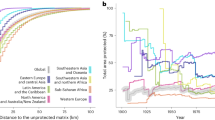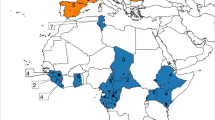Abstract
Privately protected areas (PPAs) are increasing in number and extent. Yet, we know little about their contribution to conservation and how this compares to other forms of protected area (PA). We address this gap by assessing the contribution of 17,561 PPAs to the coverage, complementarity and connectivity of existing PA networks in 15 countries across 5 continents. We find that PPAs (1) are three times more likely to be in biomes with <10% of their area protected than are other PA governance types and twice as likely to be in areas with the greatest human disturbance; (2) that they protect a further 1.2% of key biodiversity areas; (3) that they account for 3.4% of land under protection; and (4) that they increase PA network connectivity by 7.05%. Our results demonstrate the unique and significant contributions that PPAs can make to the conservation estate and that PPAs deserve more attention, recognition and resources for better design and implementation.
This is a preview of subscription content, access via your institution
Access options
Access Nature and 54 other Nature Portfolio journals
Get Nature+, our best-value online-access subscription
$29.99 / 30 days
cancel any time
Subscribe to this journal
Receive 12 digital issues and online access to articles
$119.00 per year
only $9.92 per issue
Buy this article
- Purchase on Springer Link
- Instant access to full article PDF
Prices may be subject to local taxes which are calculated during checkout




Similar content being viewed by others
Data availability
All data used in this manuscript are openly available online. Protected areas boundaries are available from http://www.protectedplanet.net/. The WWF ecoregions layer is available from https://www.worldwildlife.org/publications/terrestrial-ecoregions-of-the-world. The Global Human Footprint Dataset v.3 (2009) is available from https://sedac.ciesin.columbia.edu/data/set/wildareas-v3-2009-human-footprint. KBAs are available on request by filling out a form found at http://www.keybiodiversityareas.org/kba-data/request. Source data are provided with this paper.
Code availability
The R script used to rotate and move polygons can be found at https://github.com/cemac/rotate-move-pas. The R script for random placement of PPAs can be found at https://github.com/eerhp/Privately_Protected_Areas_Palfrey_2021.
References
Protected Planet: The World Database on Protected Areas (UNEP-WCMC and IUCN, accessed 2021); www.protectedplanet.net
Venter, O. et al. Bias in protected-area location and its effects on long-term aspirations of biodiversity conventions. Conserv. Biol. 32, 127–134 (2018).
Ward, M. et al. Just ten percent of the global terrestrial protected area network is structurally connected via intact land. Nat. Commun. 11, 4563 (2020).
Adams, W. M. Against Extinction: The Story of Conservation (Earthscan, 2004).
Watson, J. E. M. Dudley, Segan, N. & Hockings, D. B. The performance and potential of protected areas. Nature 515, 67–73 (2014).
Butchart, S. H. M. et al. Shortfalls and solutions for meeting national and global conservation area targets. Conserv. Lett. 8, 329–337 (2015).
Stolton, S. et al. The Futures of Privately Protected Areas (IUCN, 2014).
Protected Planet: The World Database on Protected Areas (UNEP-WCMC and IUCN, accessed November 2018); www.protectedplanet.net
Bingham, H. et al. Privately protected areas: advances and challenges in guidance, policy and documentation. Parks 23, 13–28 (2017).
Gallo, J., Pasquini, L., Reyers, B. & Cowling, R. M. The role of private conservation areas in biodiversity representation and target achievement within the Little Karoo region, South Africa. Biol. Conserv. 142, 446–454 (2009).
Schutz, J. Creating an integrated protected area network in Chile: a GIS assessment of ecoregion representation and the role of private protected areas. Environ. Conserv. 45, 269–277 (2018).
Ielyzaveta, I. M. & Cook, C. N. The role of privately protected areas in achieving biodiversity representation within a national protected area network. Conserv. Sci. Pract. 2, e307 (2020).
Graves, R. A., Williamson, M. A., Belote, R. T. & Brandt, J. S. Quantifying the contribution of conservation easements to large‐landscape conservation. Biol. Conserv. 232, 83–96 (2019).
De Vos, A. & Cumming, G. S. The contribution of land tenure diversity to the spatial resilience of protected area networks. People Nat. 1, 331–346 (2019).
Olson, D. M. et al. Terrestrial ecoregions of the world: a new map of life on Earth: a new global map of terrestrial ecoregions provides an innovative tool for conserving biodiversity. BioScience 51, 933–938 (2001).
Myers, N., Mittermeier, R. A., Mittermeier, C. G., Da Fonseca, G. A. B. & Kent, J. Biodiversity hotspots for conservation priorities. Nature 403, 853–858 (2000).
Borrini-Feyerabend, G. et al. Governance of Protected Areas: From Understanding to Action (IUCN, 2013).
Lee, A. & Schultz, K. A. Comparing British and French colonial legacies: a discontinuity analysis of Cameroon. Q. J. Polit. Sci. 7, 365–410 (2012).
Acemoglu, D., Johnson, S. & Robinson, J. A. The colonial origins of comparative development: an empirical investigation. Am. Econ. Rev. 91, 1369–1401 (2001).
De Vos, A., Clements, H. S., Biggs, D. & Cumming, G. S. The dynamics of proclaimed privately protected areas in South Africa over 83 years. Conserv. Lett. 12, e12644 (2019).
Conservation Programs (USDA, accessed 21 October 2021); https://www.ers.usda.gov/topics/natural-resources-environment/conservation-programs/
Zimmer, H. C., Mavromihalis, J., Turner, V. B., Moxham, C. & Liu, C. Native grasslands in the PlainsTender incentive scheme: conservation value, management and monitoring. Rangel. J. 32, 205–214 (2010).
A Global Standard for the Identification of Key Biodiversity Area (IUCN, 2021); https://portals.iucn.org/library/sites/library/files/documents/Rep-2016-005.pdf
Venter, O. et al. Last of the Wild Project, Version 3 (LWP-3): 2009 Human Footprint, 2018 Release (SEDAC, 2021); https://doi.org/10.7927/H46T0JQ4
Hoekstra, J. M., Boucher, T. M., Ricketts, T. H. & Roberts, C. Confronting a biome crisis: global disparities of habitat loss and protection. Ecol. Lett. 8, 23–29 (2005).
Newbold, T. et al. Has land use pushed terrestrial biodiversity beyond the planetary boundary? A global assessment. Science 353, 288–291 (2016).
Bengtsson, J. et al. Grasslands—more important for ecosystem services than you might think. Ecosphere 10, e02582 (2019).
Working Together for Grasslands. How Ranchers and the WWF Help Protect the Northern Great Plains (WWF, 2021); https://www.worldwildlife.org/stories/working-together-for-grasslands
Henderson, K. A. et al. Landowner perceptions of the value of natural forest and natural grassland in a mosaic ecosystem in southern Brazil. Sustain. Sci. 11, 321–330 (2016).
Kamal, S., Grodzinska-Jurczak, M. & Brown, G. Conservation on private land: a review of global strategies with a proposed classification system. J. Environ. Plan. Manag. 58, 576–597 (2015).
Williamson, M. A., Schwartz, M. W. & Lubell, M. N. Spatially explicit analytical models for social–ecological systems. BioScience 68, 885–895 (2018).
Watson, J. E. M. et al. Persistent disparities between recent rates of habitat conversion and protection and implications for future global conservation targets. Conserv. Lett. 9, 413–421 (2016).
Di Marco, M. et al. Quantifying the relative irreplaceability of important bird and biodiversity areas. Conserv. Biol. 30, 392–402 (2015).
Jones, K. R. et al. One-third of global protected land is under intense human pressure. Science 360, 788–791 (2018).
Sanderson, E. W. et al. The human footprint and the last of the wild: the human footprint is a global map of human influence on the land surface, which suggests that human beings are stewards of nature, whether we like it or not. BioScience 52, 891–904 (2002).
Clements, H. S., Kerley, G. I. H., Cumming, G. S., De Vos, A. & Cook, C. N. Privately protected areas provide key opportunities for the regional persistence of large‐ and medium‐sized mammals. J. Appl. Ecol. 56, 537–546 (2018).
Song, P., Kim, G., Mayer, A., He, R. & Tian, G. Assessing the ecosystem services of various types of urban green spaces based on i-Tree Eco. Sustainability 12, 1630 (2020).
Trzyna, T. Urban Protected Areas: Profiles and Best Practice Guidelines (IUCN, 2014).
Li, E. et al. (2019) An urban biodiversity assessment framework that combines an urban habitat classification scheme and citizen science data. Front. Ecol. Evol. https://doi.org/10.3389/fevo.2019.00277 (2019).
Venter, O. et al. Global terrestrial Human Footprint maps for 1993 and 2009. Sci. Data 3, 160067 (2016).
Rissman, A. R. & Merenlender, A. M. The conservation contributions of conservation easements: analysis of the San Francisco Bay Area protected lands spatial database. Ecol. Soc. 13, 25 (2008).
Strategic Plan for Biodiversity 2011–2020, Including Aichi Biodiversity Targets (CBD, 2011); https://www.cbd.int/sp/
Saura, S., Bastin, L., Battistella, L., Mandrici, A. & Dubois, G. Protected areas in the world’s ecoregions: how well connected are they? Ecol. Indic. 76, 144–158 (2017).
World Database of Key Biodiversity Areas (BirdLife International, accessed September 2020); http://www.keybiodiversityareas.org/site/requestgis
Saura, S. & Torné, J. Conefor Sensinode 2.2: a software package for quantifying the importance of habitat patches for landscape connectivity. Environ. Model. Softw. 24, 135–139 (2009).
R Core Team. R: A Language and Environment for Statistical Computing (R Foundation for Statistical Computing, 2014). http://www.R-Project.org/
Milam, A. et al. in Protected Areas: Are They Safeguarding Biodiversity? (eds Joppa, L. et al.) 81–101 (Wiley-Blackwell, 2016).
Mason, C. et al. Telemetry reveals existing marine protected areas are worse than random for protecting the foraging habitat of threatened shy albatross. Divers. Distrib. 24, 1744–1755 (2018).
Lewis, E. et al. Dynamics in the global protected-area estate since 2004. Conserv. Biol. 33, 570–579 (2017).
Venter, O. et al. Sixteen years of change in the global terrestrial human footprint and implications for biodiversity conservation. Nat. Commun. 7, 12558 (2016).
Schleicher, J., Peres, C. A., Amano, T., Llactayo, W. & Leader-Williams, N. Conservation performance of different conservation governance regimes in the Peruvian Amazon. Nature 7, 113–118 (2017).
Shumba, T. et al. Effectiveness of private land conservation areas in maintaining natural land cover and biodiversity intactness. Glob. Ecol. Conserv. 22, e00935 (2020).
Acknowledgements
This research was supported by the Economic and Social Research Council through the White Rose Doctoral Training Programme. We would like to thank R. Rigby for the building of the model for random placement. This paper is dedicated to the memory of E. Corcuera Vliegenthart, who did so much for PPAs.
Author information
Authors and Affiliations
Contributions
R.P. designed the study, conducted the analysis and wrote the first draft of the manuscript. GH. and J.A.O. contributed substantially to the design of the study, as well as drafting and revisions of the manuscript.
Corresponding author
Ethics declarations
Competing interests
The authors declare no competing interests.
Peer review
Peer review information
Nature Ecology & Evolution thanks Jonas Geldmann and the other, anonymous, reviewer(s) for their contribution to the peer review of this work. Peer reviewer reports are available.
Additional information
Publisher’s note Springer Nature remains neutral with regard to jurisdictional claims in published maps and institutional affiliations.
Supplementary information
Source data
Source Data Fig. 1
Data used to create Fig. 1—display of what proportion of diff gov types protect biomes with low, medium or high representation.
Source Data Fig. 2
Data used to create Fig. 2—proportion of biome protected by each PA gov type.
Source Data Fig. 3
Data used to create Fig. 3—complementarity.
Source Data Fig. 4
Data used to create Fig. 4—Proportion of Human Footprint category in each gov type.
Rights and permissions
About this article
Cite this article
Palfrey, R., Oldekop, J.A. & Holmes, G. Privately protected areas increase global protected area coverage and connectivity. Nat Ecol Evol 6, 730–737 (2022). https://doi.org/10.1038/s41559-022-01715-0
Received:
Accepted:
Published:
Issue Date:
DOI: https://doi.org/10.1038/s41559-022-01715-0
This article is cited by
-
Privately protected lands have outsized benefits
Nature (2022)
-
Policy responses to the Ukraine crisis threaten European biodiversity
Nature Ecology & Evolution (2022)
-
Conservation units and sustainable development goals: the private natural heritage reserves of Brazil
Environment, Development and Sustainability (2022)



